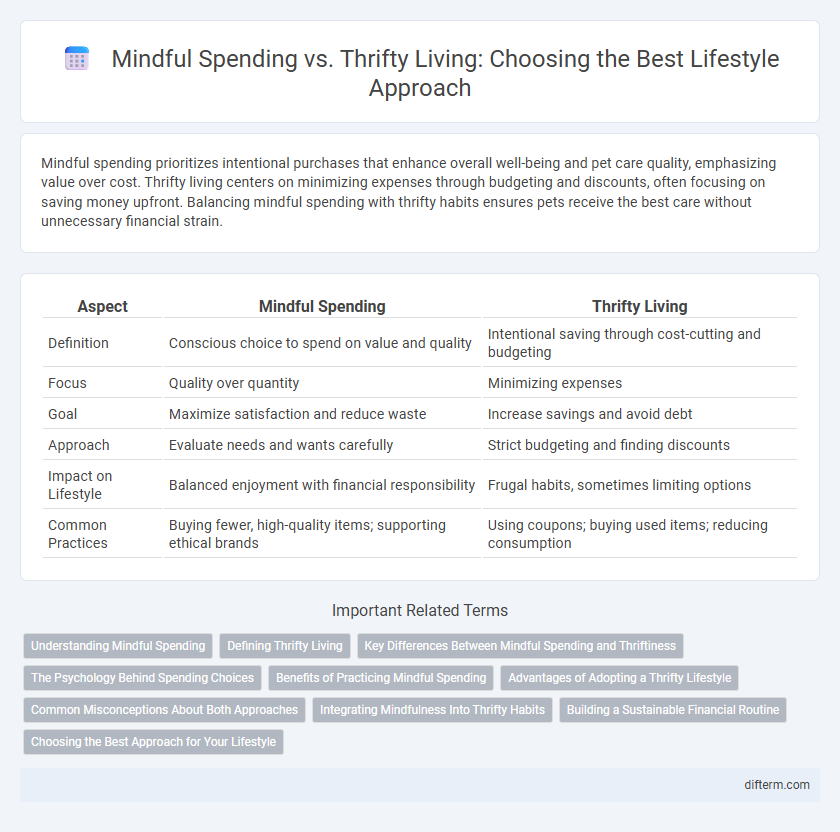Mindful spending prioritizes intentional purchases that enhance overall well-being and pet care quality, emphasizing value over cost. Thrifty living centers on minimizing expenses through budgeting and discounts, often focusing on saving money upfront. Balancing mindful spending with thrifty habits ensures pets receive the best care without unnecessary financial strain.
Table of Comparison
| Aspect | Mindful Spending | Thrifty Living |
|---|---|---|
| Definition | Conscious choice to spend on value and quality | Intentional saving through cost-cutting and budgeting |
| Focus | Quality over quantity | Minimizing expenses |
| Goal | Maximize satisfaction and reduce waste | Increase savings and avoid debt |
| Approach | Evaluate needs and wants carefully | Strict budgeting and finding discounts |
| Impact on Lifestyle | Balanced enjoyment with financial responsibility | Frugal habits, sometimes limiting options |
| Common Practices | Buying fewer, high-quality items; supporting ethical brands | Using coupons; buying used items; reducing consumption |
Understanding Mindful Spending
Mindful spending involves intentional purchases aligned with personal values and long-term goals, emphasizing quality over quantity to enhance overall well-being. Unlike thrifty living, which focuses on saving money through frugality, mindful spending prioritizes conscious decision-making to avoid impulse buying and reduce financial stress. This approach encourages reflection on needs versus wants, fostering a healthier relationship with money and sustainable consumption habits.
Defining Thrifty Living
Thrifty living involves consciously managing expenses by prioritizing value and quality over mere cost-cutting measures, emphasizing resourcefulness and budgeting to maximize financial efficiency. It reflects a sustainable approach to consumption, encouraging habits such as couponing, buying in bulk, and repurposing items to extend their lifecycle. This lifestyle fosters long-term savings and financial resilience by balancing mindful spending with practical frugality.
Key Differences Between Mindful Spending and Thriftiness
Mindful spending emphasizes intentional choices that align with personal values and long-term goals, promoting financial well-being by focusing on quality and necessity rather than price alone. Thrifty living prioritizes minimizing expenses through budgeting, discounts, and saving, often emphasizing cost-cutting and resourcefulness. The key difference lies in mindful spending's holistic approach to value and purpose versus thrifty living's emphasis on frugality and economy.
The Psychology Behind Spending Choices
Mindful spending involves conscious decisions aligned with personal values, promoting satisfaction without impulsive purchases. Thrifty living emphasizes maximizing savings through careful budgeting and cost-effective habits. Understanding the psychology behind spending choices reveals how emotional triggers and cognitive biases influence financial behavior, guiding individuals toward healthier money management.
Benefits of Practicing Mindful Spending
Practicing mindful spending enhances financial awareness by encouraging intentional purchases that align with personal values and long-term goals. It reduces impulsive buying, leading to improved budgeting and increased savings for meaningful experiences or investments. Mindful spending fosters a balanced lifestyle, promoting contentment and reducing stress related to financial uncertainty.
Advantages of Adopting a Thrifty Lifestyle
Adopting a thrifty lifestyle promotes financial stability by emphasizing budgeting, reducing unnecessary expenses, and encouraging saving for future needs. It fosters sustainable habits that minimize waste and support environmental conservation through mindful consumption. Moreover, thrifty living enhances creativity and resourcefulness, enabling individuals to make the most of available resources while maintaining a balanced, fulfilling lifestyle.
Common Misconceptions About Both Approaches
Many people mistakenly believe mindful spending means restricting all purchases, while it actually emphasizes intentional and value-driven choices. Thrifty living is often viewed as merely cheapness, but it involves strategic saving and maximizing resources without sacrificing quality of life. Both approaches aim to improve financial wellness but differ in mindset: mindful spending focuses on conscious decisions, whereas thrifty living prioritizes cost-efficiency.
Integrating Mindfulness Into Thrifty Habits
Integrating mindfulness into thrifty habits transforms simple saving into a conscious lifestyle choice that enhances financial well-being and reduces waste. Focusing on intentional purchases and appreciating the value of each item encourages thoughtful consumption, which supports both economic stability and environmental sustainability. Practicing awareness during spending moments helps develop disciplined budgeting and fosters gratitude for resources, ultimately promoting long-term mindful living.
Building a Sustainable Financial Routine
Mindful spending emphasizes intentional purchases aligned with personal values, fostering long-term financial well-being. Thrifty living focuses on minimizing expenses through cost-saving habits, maximizing resources without sacrificing quality of life. Combining both approaches strengthens a sustainable financial routine by balancing conscious choices and disciplined budgeting.
Choosing the Best Approach for Your Lifestyle
Mindful spending involves intentionally allocating your budget to purchases that align with your values and long-term goals, ensuring financial well-being without sacrificing quality. Thrifty living emphasizes cost-saving strategies by prioritizing affordability and resourcefulness in daily expenses to maximize savings. Choosing the best approach depends on personal priorities, financial goals, and lifestyle needs, balancing conscious consumption with practical money management.
mindful spending vs thrifty living Infographic

 difterm.com
difterm.com